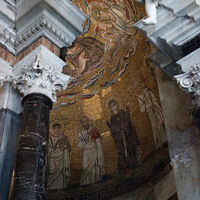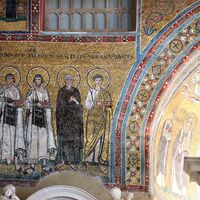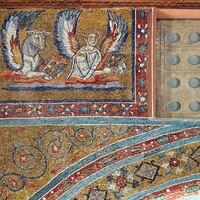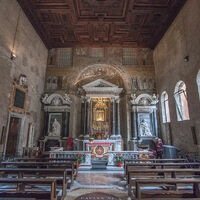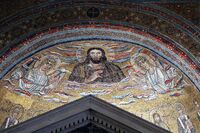Chapel of St. Venantius
Type:
Chapels
Date:
640–42
Location or Findspot (Modern-Day Country):
Italy
Description:
The Lateran Baptistery built by Constantine was enlarged several times by the addition of chapels clustered around its octagonal core. In fulfillment of a vow, Pope John IV (r. 640–42) commissioned a new rectangular chapel to house the relics of ten saints from his native land, Dalmatia (Croatia), an area being threatened and attacked by pagan Slavs and Avars. This translation marked the beginning of a trend of popes collecting and protecting endangered relics. Only contact relics were found when their container was opened in 1962, however.
Mosaics on the arched wall before the apse depict these saints in standing, frontal form, all differentiated visually and with their names inscribed above. In the apse conch, now partly obscured by a later altar, the large bust of Christ looms above the orant Mary, who is flanked by many saints of importance to the founder: Peter and Paul, Rome's leading martyrs; John the Baptist and John the Evangelist, the pope's namesakes; and two Dalmatian saints, including Venantius (for whom the chapel is named). Joining these holy figures are the two popes involved in the chapel's decoration, John IV and his successor Theodore, one of whom holds a model of it.
Such an exact correspondence between the images in the apse and the relics in the altar is unusual, and it was also very personal: John IV's father was named Venantius. The metrical inscription in the apse says, "John, consecrated bishop by God, has paid his pious vows to the martyrs of Christ the Lord, and, using metal that gleams like that of the holy font [in the adjacent baptistery], he has now, with foresight, joined this work [to the font] to the end so that any[one] stepping [here] and, prostrate, adoring Christ, may also gain the prayers he has poured forth to heaven above." Papal patronage, saints' cults, and material splendor unite in this chapel and resonate with its adjoining space made by Constantine. As a whole, the Lateran Baptistery thus registers a shift in patronage from emperor to pope, a shift deriving from the move of the imperial capital to Constantinople and the increasing power of the Roman Church.
Mosaics on the arched wall before the apse depict these saints in standing, frontal form, all differentiated visually and with their names inscribed above. In the apse conch, now partly obscured by a later altar, the large bust of Christ looms above the orant Mary, who is flanked by many saints of importance to the founder: Peter and Paul, Rome's leading martyrs; John the Baptist and John the Evangelist, the pope's namesakes; and two Dalmatian saints, including Venantius (for whom the chapel is named). Joining these holy figures are the two popes involved in the chapel's decoration, John IV and his successor Theodore, one of whom holds a model of it.
Such an exact correspondence between the images in the apse and the relics in the altar is unusual, and it was also very personal: John IV's father was named Venantius. The metrical inscription in the apse says, "John, consecrated bishop by God, has paid his pious vows to the martyrs of Christ the Lord, and, using metal that gleams like that of the holy font [in the adjacent baptistery], he has now, with foresight, joined this work [to the font] to the end so that any[one] stepping [here] and, prostrate, adoring Christ, may also gain the prayers he has poured forth to heaven above." Papal patronage, saints' cults, and material splendor unite in this chapel and resonate with its adjoining space made by Constantine. As a whole, the Lateran Baptistery thus registers a shift in patronage from emperor to pope, a shift deriving from the move of the imperial capital to Constantinople and the increasing power of the Roman Church.
Relevant Textbook Chapter(s):
3
Repository and Online Resources:
• For more views of the mosaics, visit the Kornbluth Photography website.
Image Credits:
Wikimedia Commons


